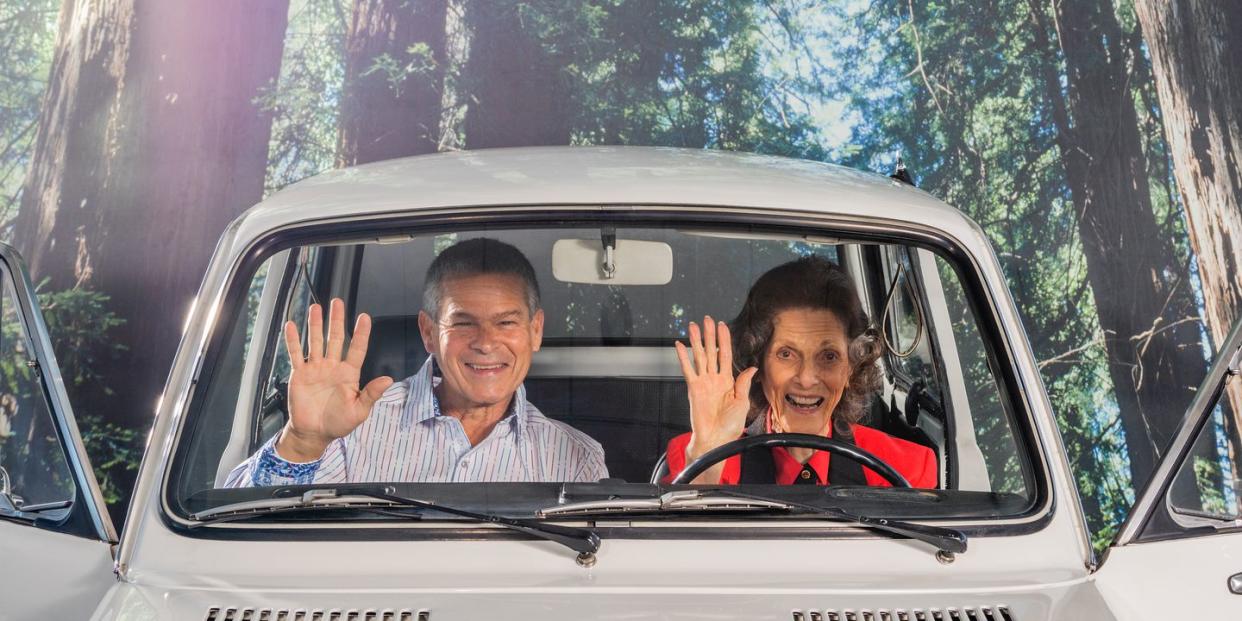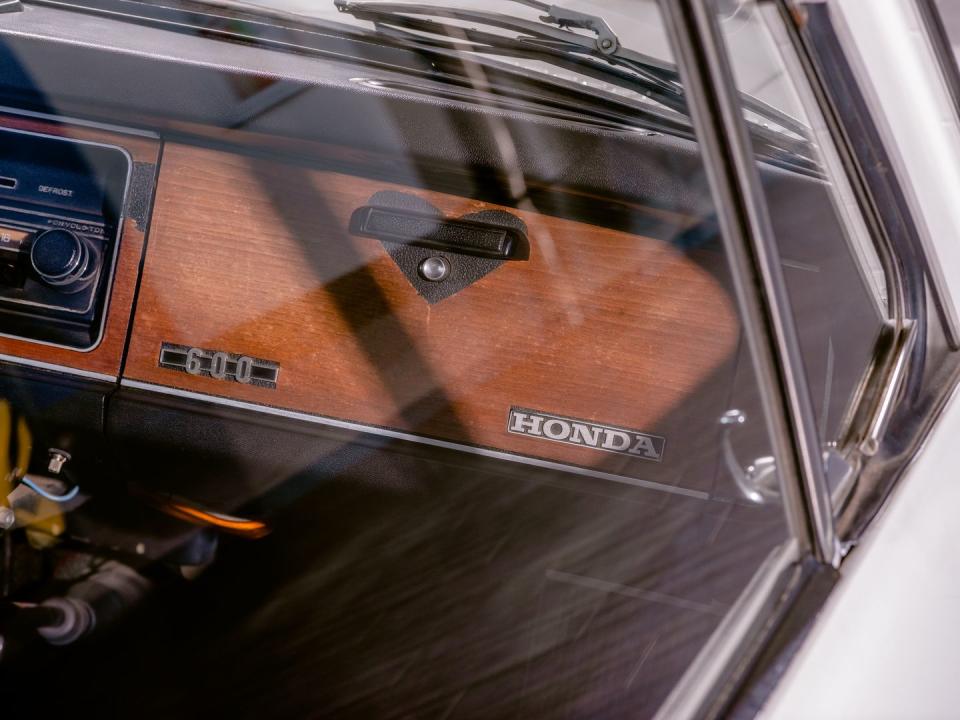The California Dealer That Risked It All to Sell America's First Hondas

Lori and Bill Manly saw their first Honda car at the factory in Suzuka, Japan, in 1967. They’d won a trip to Japan from American Honda, a commendation for the sales volume at their eight-year-old motorcycle dealership, Honda of Santa Rosa, an hour north of San Francisco. “We sold a lot of motorcycles,” says Lori Manly, now 88.
The car, the Honda N360, was unlike anything on American roads. It weighed just over 1000 pounds. It had a transversely mounted, air-cooled, two-cylinder alloy engine under its tiny hood, driving the front wheels through a four-speed manual transmission. It had wheelbarrow-sized 10-inch wheels. It took nearly 20 seconds to accelerate to 60 mph. With just 118 inches of vehicle between its chromed bumpers, it was three-and-a-half feet shorter than a VW Beetle. In fact, it was a foot shorter than the wheelbase of a contemporary Cadillac Coupe DeVille.
This story originally appeared in Volume 4 of Road & Track.
SIGN UP FOR THE TRACK CLUB BY R&T FOR MORE EXCLUSIVE STORIES


Bill and Lori were smitten. “My dad was a fabulous mechanic and a car lover,” says Brian Manly, who now runs the family dealership. “I think he gravitated toward the quality of the Honda brand. He could recognize quality. He said to my mom, ‘If it’s anything like their motorcycles, I bet it’s a pretty damn good car.’”
The Manlys immediately began a campaign to sell Honda’s little car to their customers. The following year, they got word that American Honda was considering bringing the new N600, a slightly more powerful version of the N360, stateside. “As Honda decided to offer a car in the United States, they went to their friends and family first, and those were the California motorcycle dealers,” says Steven Center, Honda’s current vice president of automobile sales. “They were picked because of their culture and their attention to consumers, service, and quality.”
The Manlys were among those chosen, but Bill had a special request. “My dad asked to be dealer number one,” says Rita Manly Case. She grew up in the family business, and now runs one of America’s largest privately owned car dealership groups. “He said, ‘Somebody has to get dealer number one, and I want it to be me.’”
Honda required its 32 new franchisees to house their car dealerships separate from their bikes, so the Manlys purchased a former boat dealer nearby and moved the motorcycles there. “And on the side of the alleyway was a little bitty showroom for the car,” says Rita, who was just 16 at the time. “This was where I sat. So I was literally the first salesperson for the Honda car.”
Because of bureaucratic hurdles, it took two years for the first cars to roll in. (“We didn’t have any cars, so we put in a pool table,” Lori told a local reporter.)
“The Japanese Ministry of Industry and Trade ruled with an iron fist, and they told the Japanese manufacturers to pair up with an American company and sell through them,” says Center. GM had a history with Isuzu dating back to the Twenties, Ford had recently begun its partnership with Mazda, and Chrysler was deep in talks with Mitsubishi. The Ministry told founder Soichiro Honda that the Big Three was full up. “But he was a spirited guy and didn’t take no for an answer. He found a way to do it,” Center says.
Finally, in 1970, the first N600s arrived at the local port. The Manlys had received an allotment of exactly one vehicle. They sold it before any other California dealer notched a sale. “So we were the number-one car sale in the continental U.S.A. for Honda,” Lori says.
Bill and Lori Manly didn’t set out to become pioneering Honda dealers. Married in 1950 when Bill was 22 and Lori was 17, they were thrill seekers. Bill had grown up steeped in SoCal hot-rod culture. “We had Model As—two-doors, four-doors. We went to all the hot-rod meets,” Lori says. “Cars were a big part of our life.” They raced on the Bonneville Salt Flats. They flew vintage planes.
They also sought opportunity. When European cars began appearing at races, the Manlys saw a potential business. They opened Foreign Automotive in the mid-Fifties, servicing and repairing machines from Germany, Italy, and Britain.
In 1957, Cotati Raceway opened on an old naval airfield. The San Francisco Region of the SCCA held events there, and as aficionados and proprietors of a local shop, the Manlys attended, working on client cars and getting their name out to potential customers.
One day in 1959, they were at the track as support crew for a Triumph driver. “A pickup truck rolled into the pit area, and the driver said they were looking for us,” Lori says. The driver was from newly formed American Honda, which had just opened in a storefront on Pico Boulevard in Los Angeles. He offered the Manlys a gamble.


Honda was looking to introduce a new take on the motorcycle to America, the handsome, affordable, approachable Honda 50. It would entice enthusiasts but also appeal to ordinary riders. Honda didn’t want to associate its product with the noisy, rowdy, finicky bikes from Harley-Davidson, BSA, or Triumph, so it sought franchisees outside the normal channels. “They wanted Honda motorcycles sold through sporting goods stores, or animal feed stores, or . . . maybe a foreign-car garage,” says Brian.
The Manlys had never heard of Honda. At the time, “made in Japan” had a negative connotation for many Americans. But the bikes intrigued them, and they quickly said yes. “We took on the units, we got ahold of our sports-car clients, and we arranged weekend trail rides,” says Lori. “And they loved it.”
The kids loved it, too. “I remember going on these trail rides when I was six, seven years old,” says Brian. “I would sit on the rack of a Honda Trail 50 while my mom and my sister rode and I bounced around.” Customers tore up the Napa hills on Sundays, then came to the shop to buy $250 bikes for themselves and their families.
To further push the product, the Manlys set up bike races during lunch breaks at SCCA events. Soon, they helped found a Honda motorcycle racing series and competed themselves. “My mom was the first female Honda road racer. She raced from 1963 to 1965,” says Rita. “She raced Sears Point, Laguna Seca, Riverside, and very successfully.”
Honda launched a major print and TV campaign: “You meet the nicest people on a Honda.” The Beach Boys wrote a hit song, “Little Honda.” The bikes became a sensation, with more than 100,000 sold per year. “As it grew, and the customer base got bigger, we decided to get out of the repair business and just take on these motorcycles,” Lori says. They ditched Foreign Automotive, bought a building, and dealt Honda bikes full-time. As one of the first U.S. Honda dealerships, they even had a direct phone line to Japan.
Manlys managed to move the first Honda N600 in the States, but it was not an easy sell. “People pooh-poohed the car. They said, ‘This little thing? We’re going to get run over on the freeway with all the Cadillacs and Chryslers,’” Lori recalls. Rita concurs. “The other dealers were all laughing at my dad in those early years,” she says. “People called the cars ‘pregnant roller skates.’” Brian recalls the N600 as a toy-like presence in the showroom. “A Honda 750 motorcycle with the mirrors on sat higher than it, and I think it cost $100 more,” he says.
But the Manlys persevered, in search of a market for $1395 cars. “We decided that we would push it to college kids as inexpensive transportation for young people,” Lori says. Rita was one of the unexpected victims of this strategy. She drove an N600 for her senior year of high school. “The kids would pick the thing up and turn it sideways in the parking spot so she couldn’t get out,” Brian says. In the N600’s first model year, the Manlys sold just 10 cars. “The whole U.S. never noticed the Honda N600. They deemed it laughable,” Rita says.
Inexpensive but disposable, the N600 was not a resounding success. Most had a service life of about 65,000 miles before needing a major engine rebuild. But the people who did buy them evangelized for the brand. The Manly family had given many people their first look at a Honda badge on a car. When the thrifty and more fully realized Civic arrived in the middle of the 1973 fuel crisis, thousands rushed to purchase a Honda hatchback. “It was like a cult,” says Center. “[The customers] did all the selling, sort of like Tesla today.”

The customers weren’t wrong. “When you compared them to American cars of the day, 60- or 70,000 miles was a lot to put on a Chrysler,” Lori says. “On a Honda? You got over 100,000 miles, and then people would bring them in for a trade-in.”
The Manlys embraced this practice. In 1980, one of their original N600 customers brought in his car, with 90,000 miles on the clock, looking to trade up to a newer model. Honda had found huge success in the subcompact Civic. Its radical CVCC engine was capable of meeting the stringent emissions requirements of the 1970 Clean Air Act without a catalytic converter, and it sipped gasoline that had quadrupled in price following the OPEC oil embargo. And the automaker had just released the Accord, a sporting and efficient family sedan.
Both cars were full-blown hits. “Once the Civic came out, that was a whole different ball game,” Lori says. “We had a waiting list of people nine months long.” In 1970, Honda sold just over 4000 cars in America; in 1980, more than 375,000.
Suddenly, everyone wanted to be selling Civics. But Honda chose to work exclusively with those dealers that invested in a separate facility to sell N600s back in the day. For their loyalty, and for continuing to take a chance on Honda, the automaker made the Manlys part of its success story.
The Manlys accepted that N600 on trade, but they didn’t resell it. It still sits in their showroom, a reminder of where they, and Honda, began. Bill passed away in 2017. Lori still comes to the office every day. “For years, she would ride a motorcycle to work,” Brian says. Now she drives an S2000. “I love it. It handles beautifully, it has plenty of get-up-and-go,” she says.
Asked what drew her and Bill to this unknown, unproven brand 60 years ago, Lori pauses. “We looked at it and thought, ‘This looks like fun.’ We were looking more into the fun aspect than something to sell,” she says. “We had a great time.”
SIGN UP FOR THE TRACK CLUB BY R&T FOR MORE EXCLUSIVE STORIES

You Might Also Like

